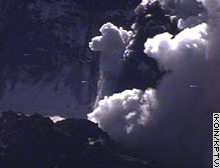Scientists monitor Mount St. Helens after eruption
 |

Mount St. Helens
blew smoke and ash Friday afternoon. |
 |
|
 |
 VIDEO |
 Video of Mt. St.
Helens in Washington spewing smoke and ash.
|
|
VANCOUVER, Washington (CNN) --
Scientists are closely watching Mount St. Helens after a small
eruption spewed smoke and ash thousands of feet Friday before
another earthquake rattled the volcano.
A series of small earthquakes was detected in the week before the
Friday afternoon's eruption. This seismic activity decreased shortly
after the noon (3 p.m. ET) eruption, but picked up again within
hours.
Peter Frenzen, a scientist with the Mount St. Helens National
Volcanic Monument, said a 2.0 magnitude earthquake was detected.
One scientist described the eruption as a "hiccup."
The volcano spewed a harmless plume of steam and ash into the air
Friday, the biggest eruption by the volcano in 18 years.
A small explosion was detected on the south side of the volcano's
lava dome, where cracks had been detected in a glacier, said John
Major of the U.S. Geological Survey.
The mountain then vented a combination of steam and ash for 24
minutes, sending a pale gray column nearly 10,000 feet into the blue
Washington sky.
"There is no indication that magma has reached the surface,"
Major said.
Molten rock is called magma before reaching the surface where it
then becomes lava.
Scientists said the presence of magma could indicate the
potential for a more serious eruption.
Geologist Tom Pierson said the event "was really a hiccup.
[Eruptions] could be a little bigger once real magma is
involved."
A visible plume -- which was mostly steam but contained some ash
-- moved southwest about six miles, Major said.
The Portland, Oregon, metropolitan area lies about 50 miles
southwest of Mount St. Helens.
The water flow out of the crater appears to have increased since
the eruption, though no potentially destructive mud flows were
reported, he said.
Scientists saw this coming
Scientists had been predicting just such a minor eruption after
swarms of small earthquakes were detected and the mountain's
volcanic dome shifted three inches since Monday.
"This is exactly the kind of event that we've sort of been
talking about and anticipating over the past several days. This is a
fairly small eruption," Major said.
In anticipation of an eruption, the mountain was closed to
hikers, and the media and sightseers gathered at a visitors center
five miles away.
Major said none of the scientists working on the volcano at the
time of the eruption were injured.
Friday's eruption was a mere sideshow in comparison to the
cataclysmic eruption May 18, 1980, which blew off more than 1,000
feet from the top of the mountain.
That eruption killed 57 people, left deep piles of ash hundreds
of miles away and caused $3 billion in damage.
After that disaster, small eruptions continued at Mount St.
Helens until 1986, when the volcano finally went quiet. Major said
Friday's eruption was comparable to the minor eruptions seen during
that period.
The lava dome was built up inside the crater left by the 1980
eruption by the smaller eruptions that followed it.
Flights delayed
The Federal Aviation Administration temporarily diverted an
unknown number of commercial aircraft after the eruption, primarily
affecting air traffic in the Portland area, spokesman Allen Kenitzer
said.
Alaska Airlines canceled five flights and diverted four
Portland-bound planes to Seattle, airline spokesman Sam Sperry said.
The airline has since resumed normal operations.
The FAA is also advising low-altitude aircraft of the volcanic
activity but has not issued flight restrictions, Kenitzer said.